Before Watchmen: Minutemen #1 (DC, $3.99)
By Jeb D.
(N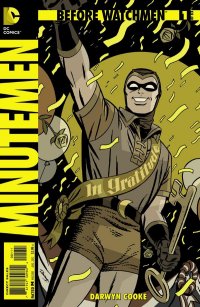 ote: I am posting this before having read what my colleague, Adam, has to say about the same comic, to be posted below. I have no doubt he’ll be more eloquent on the subject, and look forward to seeing what he comes up with).
ote: I am posting this before having read what my colleague, Adam, has to say about the same comic, to be posted below. I have no doubt he’ll be more eloquent on the subject, and look forward to seeing what he comes up with).
And so it begins.
You know, the ideal reviewer for this series of Watchmen prequels would be a comics reader who has somehow avoided the original series up to this point, and who has no preconceived notions about the Moore/DC controversy. Sadly, our merry band of four-color marauders has none such in its membership, so I guess you’re stuck with me–as it happens, a member of that rarified group old enough to have read the original series as it was first being released, which means I have about as many preconceived notions as it’s possible to have.
To quickly dispense with the commercial aspects of the Moore/DC situation: Yes, Moore and Gibbons signed a contract with DC, but all parties involved fully expected its terms to allow the property to revert to the creators in relatively short order (keeping a series in print for more than a year was decidedly atypical back then); when the entire comic retailing landscape suddenly changed (due in no small part to the success of Watchmen), it was pretty small-minded for the corporation to insist on the letter, not the spirit, of the contract, given the lost potential for a rewarding, ongoing, partnership. On the other hand, this kind of shit happens all the time, and on any given day, my money is probably helping to worsen some situation somewhere, of which I’m completely unaware, that would make this seem like a pretty minor kerfuffle. So while I’m fine with anyone deciding not to buy these books on principle, I just figure that the comic shop could use whatever share of my four bucks they get to keep, and move on.
Now as to the artistic validity of the project: yep, Moore himself had ideas for prequels, spinoffs, and the like. But I’d like to think that his concepts were intended to function as his own living, breathing extensions of what was then a current piece of work, as opposed to having hired guns dotting the i’s and crossing the t’s of a quarter-century-old property that is already the most-discussed, dissected, and influential comic of the past three decades, if not of all time. It’s certainly possible that future volumes may set their sights higher than that, but this first installment, revisiting the original 1950’s era Minutemen, isn’t giving me a lot of hope.
Be honest: was one of your criticisms of Watchmen that Moore and Gibbons failed to make it clear that The Comedian had “…moments of uncontrolled rage brought on by traumatic events” in his childhood? Because if so, writer/artist Darwyn Cooke will clear that right up for you: on page 19, The Comedian says “My caseworker says I have moments of uncontrolled rage brought on by traumatic events my childhood.” In Watchmen, was the imposing nature of Hooded Justice insufficient for you to get the idea that he made criminals pee their pants? Wonder no more: Cooke has him thrash a few hoodlums in classic badass vigilante style, and is then very specific to show one of them literally urinating in fright. For those too dull to get the idea that a superhero called “Dollar Bill” had a touch of the mercenary about him, there’s an entire page explaining the concept. And what on earth were Moore and Gibbons thinking in limiting our information about Silhouette’s gender proclivities to the gory sight of her corpse below the word “lesbian” painted on the wall in blood? Putting things to rights, Cooke not only illustrates one of her encounters with bad guys, but is very clear to refer to her (in tones of shocked tolerance) as “a lesbian.” It’s Watchmen for Dummies.
And, really, this doesn’t even begin to get into the biggest creative trap of the entire project: that these characters only ever existed to provide backdrop for the story of Watchmen, that their entire point is to personify an era when the sort of difficult, interesting questions about power, sex, and authoritarianism that Moore and Gibbons raised weren’t even being discussed (that being left to the actual series). In other words, the very idea of interesting insight is almost anathema.
As I say, in some ways, this probably works better for the new reader, for whom this might actually be new information; but, then, they would likely miss the intended resonance of this being Hollis Mason reminiscing about his onetime compatriots. I don’t know how much of the book’s direction came from Cooke, and how much was laid out as a corporate priority, but the script feels like it’s trying to be all things to all readers, and at least for this “experienced” reader, it just feels like it comes up short for anyone: it’s heavy-handed (which Moore was certainly capable of being here and there), and definitively on-the-nose (which he rarely was).
Given the setting, Cooke was the obvious artistic choice for this book, with his familiar “retro-futuristic” “See-The-USA-In-Your-Chevrolet” Madison Avenue-isms (the production designers on Mad Men have nothing on Cooke; wouldn’t surprise me to learn they’d lifted a few things from him, in fact). The somewhat downbeat appearance of the Minutemen themselves (as opposed to the more colorful Justice League characters) robs the book of some of the Jet Age flashiness of New Frontier, but that’s appropriate for the story’s tone, and fans of the artist’s style have nothing to complain about in this comic, at least visually.
I should also mention the “back-up” feature: the first (two-page) installment of an ongoing “pirate story” (because what’s Watchmen without a pirate story?), written by original Watchmen editor Len Wein, who famously clashed with Moore about the series’ ending. Given that Wein dispenses with any sort of measured buildup to this story (no calm whatever before this storm), and gets right to the point by immediately having one pirate gruesomely executed (depicted in loving detail by artist John Higgins), with prose even more purple than the style that Moore was parodying, I’m less enthusiastic to learn what he might have had (or possibly still has) in store for the “real” ending to Watchmen, or to the rest of this story.
Given the talent involved in all these comics, there’s no point in dismissing them en masse: any serious fan of Darwyn Cooke is going to want to see his latest project, regardless of what it is, and the same will hold true for fans of creators like Amanda Conner, Brian Azzarello, or J.G. Jones. And I don’t doubt that some of them will turn in some great-looking stuff. I just don’t know that it will add up to much; Minutemen #1 certainly doesn’t.
Rating: 




Out of a Possible 5 Stars
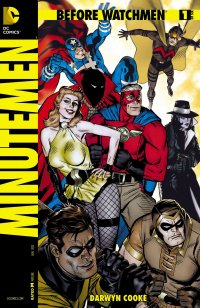 Before Watchmen: Minutemen #1 (DC, $3.99)
Before Watchmen: Minutemen #1 (DC, $3.99)
By Adam Prosser
The idea of an “unbiased” review is something of a joke, but I really do want to engage with this comic, the corporation behind it, and readers of this column as honestly and straightforwardly as possible, so let me get this out of the way right up front.
I hate that this comic exists. I think its very existence comes from a sleazy, cynical place that disrespects creators in general—not just Alan Moore, but the very idea of comics being a creative endeavour rather than generic product. I think it damages the medium. I think even DC comics as a corporate entity is being hurt by this comic, no matter what the sales figures turn out to be, because in the long run it’s killing the goose that lays the golden eggs, and chasing the next temporary sales high instead of dealing with the fundamental problems that are plaguing the industry. I think the concept behind this comic is beneath the dignity of everyone involved. Rest assured I was comped a copy for review; I flatly refuse to pay money for it, and I urge you to do the same, even if it turns out to be absolutely brilliant. (I write this paragraph not having cracked the book open yet.)
There’s no point in pretending this isn’t relevant. Art doesn’t exist in a vacuum, and a bland recitation of this comic’s strengths and faults would be just as useless at providing a sense of whether or not to buy it as it would be at adding to the general conversation about this comic. If you think this makes me an untrustworthy reviewer, so be it, but as least I’m being up front about it.
That said: as morally repugnant as this comic’s existence is to me, I’ve never denied that it could potentially be a good comic. I mean, the creative team for the Before Watchmen line is bewilderingly mediocre (another sign of how cynical DC is being about all this—it’s like bringing in Len Weisman to direct a sequel to Casablanca), but at least this particular comic is by Darwyn Cooke, by far the biggest talent involved in this project. Furthermore, the idea of doing a comic about the Minutemen, the “first generation” of heroes in Watchmen about whom we learn very little, is probably the least offensive in concept of all the Before Watchmen titles*. I don’t think it’s a coincidence that this is the first Before Watchmen book to hit the stands. So maybe. Maybe this might be worthwhile. Maybe?
The problem is this. In some impossible other dimension where you could step back and somehow forget this is a Watchmen prequel, what you’d see is…a pretty bland, though well-executed, homage to Golden Age comics, featuring an array of characters who get brief introductions but little that’s particularly deep or interesting. It reminds me quite a bit of Cooke’s Spirit book from a few years back, which had the same level of technical proficiency but failed to capture the formalistic imagination that Will Eisner brought to the comic—-and without that, you’re left with a pretty bland, generic character. The same is true here; there are maybe a couple of potentially interesting moments, like the warm-hearted, slightly revisionist characterizations of Mothman and The Silhouette, and a potentially meta-moment where the opening, overwritten narration is broken into by an author criticizing his own work…but on the whole, even if this were a purely original comic there’d be nothing here we haven’t seen before.
And of course, no one is going to see it on that level anyway. This is a Watchmen prequel, DC WANTS you to see it as a Watchmen prequel, and the number of readers who will pick it up mistaking it for one of the (it must be said, many) neo-Golden Age books on the shelves right now are pretty minimal. So it’s only fair to compare to Watchmen. And, surprise! It doesn’t stack up. Other than the aforementioned snatches of characterization I mentioned above, there’s literally nothing in this issue that we didn’t learn from Watchmen itself, which just emphasizes the pointlessness of this whole idea and how beautifully self-contained and unneeding of embellishment the original graphic novel is.
One of the interesting things about DC comics is that their great comics tend to be more self-contained than Marvel’s; in a way they straddle the line between graphic novels and ongoing floppies. When you talk about their most significant works, they tend to be discrete stories like All-Star Superman and The Dark Knight Returns and Kingdom Come and Superman: Red Son and Crisis on Infinite Earths, rather than lengthy runs on a title. I think this is tied into the nature of DC’s characters as more static, vs. Marvel’s more fluid, constantly-evolving characters and stories, but it also means DC is more reverent towards its own past and its iconography. This can be a good thing, but it also tends to mean that DC is stuck in the past, constantly trying to evoke its iconic stories in a play for thematic weight, often in comics that don’t really deserve it (hello, Geoff Johns!) Before Watchmen is the latest symptom of this—besides Watchmen itself, there are subtle nods to Batman: Year One and the opening page evokes All-Star Superman. Following Watchmen is enough of a challenge that I’m not sure why Cooke would want to invite comparisons to even more great comics and remind you what you could be reading. But this seems to be the idea behind these books: coast on nostalgia and maybe creativity won’t matter. At least they’re consistent.
*With the possible exception of the Tales of the Black Corsair backups by Len Wein and John Higgins that will be running in every issue. This one, and presumably all the others, are a mere two pages long, so it’s virtually impossible to review right now. Some piratey things happen. That’s all.
Rating: 




Out of a Possible 5 Stars
Action Comics #10 & Superman Family Adventures #1 (DC, $3.99 & 2.99)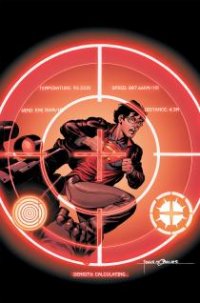
By D.S. Randlett (twitter: @dsrandlett)
So I guess that Grant Morrison is interested in his Action Comics run, after all. The first arc of the series was something of a disappointment, even though I would hesitate to say that it was outright bad. It was very uneven, with one issue being quite good, with the very next not quite measuring up. It still had a certain energy to it, but up until last month’s issue the plot felt completely disconnected from character. All of Morrison’s good ideas, in turn, felt rudderless.
There are many things that the latest issue of Action Comics does very well. For one, it upends some of the criticisms that this look at Superman’s early years was basically turning him into Spider-Man. Morrison and Morales introduce a pretty deliberate Kraven the Hunter knockoff named Nimrod, only to pull the rug out from under that particular story. The cover and the solicits advertise the death of Clark Kent, and that does happen, but not in the way that you’re lead to expect. The payoff to that promise is far sadder than that, and it actually ties into some of the emerging thematic threads of this series.
Best of all, though, is that after nearly a year, a Superman comic is finally starting to get a grip on its lead character. There’s a scene involving the JLA where Superman is trying to convince them that they need to be more active in solving problems like starvation and poverty, but they’re having none of it. While Batman does voice some pretty sound reasoning for his stance, it is a scene that throws Superman himself into pretty stark relief when compared to the rest of the superheroes. There are some overtones of class in this scene, and they’re well taken, but it also shows how Superman’s reasons for being a superhero involve more than saving the planet from aliens: it’s a quest for moral purpose. Batman says, as the scene closes, “One of these days we’ll all have to go after him.” It’s a delightful piece of double talk. Either the billionaire is thinking about how he’ll have to enlist his superpowered pals to take down the ambitious proletarian, or he sees that Superman is who they are all going to be following.
It’s nice having a full issue drawn by Rags Morales again, particularly this one. This is certainly the most humane issue of a Superman comic that there’s been in quite a few months, and his style seems softer here in order to capture that. There’s a melancholy here, but it is that of a sincere hope that isn’t necessarily futile. It also appears that Morrison is officially Up To Something when it comes to the plot, and it will be interesting to see what that is.
 For the younger readers that you may know, there is also the delightful Superman Family Adventures by Tiny Titans creators Baltazar and Franco. The story is kind of fluffy. Lex Luthor and some Lexbots invade Metropolis, and its up to Superman, Supergirl, Superboy, and Krypto to save the day. And they do. But then, that hardly seems to be the point here. The plot may be familiar, but it functions as mainly a vehicle for fast-paced action and funny gags.
For the younger readers that you may know, there is also the delightful Superman Family Adventures by Tiny Titans creators Baltazar and Franco. The story is kind of fluffy. Lex Luthor and some Lexbots invade Metropolis, and its up to Superman, Supergirl, Superboy, and Krypto to save the day. And they do. But then, that hardly seems to be the point here. The plot may be familiar, but it functions as mainly a vehicle for fast-paced action and funny gags.
The target audience is children, but for grownups it’s a real pleasure to be able to revel in some of the goofier aspects of the Superman mythos in a way that’s appropriately goofy. Superman Family is shallow, but it’s a great reminder of how fun Superman comics can be when they want to be. A real standout here is Jimmy Olsen, and the gag on the last page is golden.
A few months ago, the state of Superman seemed to be getting pretty dire. Thankfully, these two issues serve as something of a course correction, and hopefully point to a brighter future for my favorite superhero.
Action Comics #10
Rating: 




Out of a Possible 5 Stars
Superman Family Adventures #1
Rating: 




Out of a Possible 5 Stars
The Advance Team OGN (Tor, $15.99)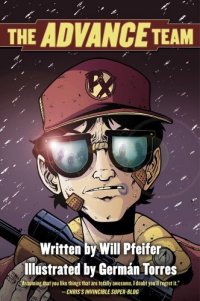
by Graig Kent
I have a lot of respect and affection for comics scribe WIll Pfeifer. When he was in the DC stable, he wrote some of my favorite stories of the past decade including an extraordinary run on Catwoman, a short but highly memorable stint on Aquaman, the surprising Captain Atom:Armageddon mini-series; and probably the most underrated yet cleverly executed series of the aughts, H.E.R.O. (based on the Dial “H” For Hero concept). It was disheartening to see him squeezed out of DC after the Amazons Attack debacle and also not receive the broader success his talent surely should command.
Knowing what Pfeifer is capable of, and knowing the impact his work has had on me previously, I hesitate to express the disappointment I feel over his new original graphic novel, The Advance Team. It’s not a terrible by any stretch, but it certainly doesn’t measure up to the standard I hold Pfeifer to.
The book follows Zack, a pizza delivery boy who very quickly learns that his life, and the world he knew, isn’t all that it seems. A chance mugging leads to Zack’s discovery of fantastic abilities. The sudden reappearance of “Uncle” Archie, a friend of his deceased parents, slowly starts shedding light on Zack’s changes. Archie’s cryptic guidance only serves to further unfurl Zack’s life as he becomes embroiled in a plot to kill aliens in human disguise, the titular Advance Team for a full scale invasion.
The story moves with relentless momentum, a breakneck pace that actually does a disservice to its lead character, leaving Zack very little time to process what he’s discovered or reflect upon the meaning of his actions. Zack himself is a bit of a void. Though he narrates the story, and Pfeifer utilizes thought balloons often (bless him for using thought balloons and not being cheesy about it), we’re never truly privy to Zack’s innermost thoughts. He seems to have no understanding of what is happening to him, no say in his involvement in the events he’s instigating, and no real will of his own to speak of. There’s very little in the way of emotion surrounding what happens. He’s neither excited nor frightened to any great degree, more reticent and accepting of it all at every turn. He has focus on the cute girl he works with at the pizza shop, but their relationship seems to go from co-workers to soul mates without much to back it up.
There’s a “Last Starfighter” quality to the book, for better or worse, which makes me wonder, knowing that Pfeifer is quite the cinephile, whether these faults in characterization and storytelling are an intentional pastiche, It does have a certain clunky 1980’s charm to it (though it’s referenced that it’s set in 2012), and the familiarity in it’s “chosen one” plot makes it quite easily digestible.
Pfeifer is accompanied by artist Germán Torres who brings a clean, confident, light cartooning style to the pages that keeps the book from ever getting too heavy. Torres’ character designs are reminiscent of the Sixth Gun‘s Brian Hurtt or The Secret History of DB Cooper‘s Brian Churilla, with simple, but purposeful, linework and details. He’s got a strong sense of light and dark, but employs shadows minimally and for effect. His environments are always well built, the details in his backgrounds and simplicity of execution are impressive. Where Torres is weak is in his characters’ physicality, particularly the fight sequences are stiff and unnatural, though they do get progressively better.
Perhaps not a full mis-step in Pfeifer’s big comeback to comics, but The Advance Team serves only a placeholder for fans to rest upon while waiting for most assuredly better things to come.
Rating: 




Out of a Possible 5 Stars
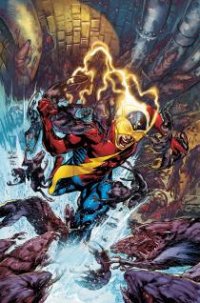 Earth 2 #2 (DC, $2.99)
Earth 2 #2 (DC, $2.99)
By D.S. Randlett (twitter: @dsrandlett)
So maybe you’ve heard a little bit about this one. Alan Scott, the alternate universe Green Lantern, is gay. I suppose that it’s a grand enough revelation, but it’s treated here with little fanfare. Alan meets his boyfriend at the airport, they kiss, and the story moves on. It’s actually a very sweet moment, and the true revelation of Earth 2 makes it possible: Nicola Scott, the series’ artist.
Nicola Scott is one of my favorite superhero artists currently working. She has an eye for action and detail to be sure, but also a great actor. It’s to her credit that the controversial kiss feels sincere instead of shocking or leery-eyed. It’s also impossible not to adore her depiction of Alan Scott, who comes across as a kind, wide-eyed ox of a man.
Of course, this issue hardly concerns Alan Scott at all, but rather centers around Jay Garrick, who becomes The Flash after an encounter with the dying god, Hermes. The Golden Age versions of these heroes are getting some costume redesigns. Most of Garrick’s costume looks actually pretty good, but I can’t get behind his updated helmet. It speaks more to the Legion of Superheroes than to the story being presented here, and I think that this costume would just flat out look better with the old school Hermes helmet.
But still, this is a fun series, even if it can feel pretty dour at times. This other Earth also repelled an invasion from Apokolips, but the deaths of Superman, Batman, and Wonder Woman in the first issue has led the world to become a bit more dystopian than the mainline DCU. But still, there’s a sense of play to this series. It’s been hard for a lot of people to really accept the rebirth of the DCU’s multiple worlds, but I like the story possibilities that that presents too much to really roll my eyes too hard. This particular stable of characters is robust enough that we can imagine them a little bit differently than we’re used to, and the multiverse allows us to explore those possibilities while still satisfying the fans’ desire for continuity.
James Robinson, writer of the superlative Starman, returns to write younger versions of characters who were once the “old guard,” and the alternate universe setup allows him to play in a realm that feels dangerous, like it has stakes, which is something that the main DCU has lacked, even as good as some of the books might be. If the multiverse is a way to hack continuity, a way to explore long form superhero fiction that still feels like it has a limit and a sense of structure, I’m all for it.
Still, for all that’s good about it, Earth 2 is not yet a series that I feel like I can love. For all that’s different, and all the possibilities that are present, the book’s style and narrative tacks a little too close to the typical, a bit too familiar. Of course, future issues and story arcs may change that perception, and the book may herald an opening for exploring different ideas in the DCU. But my faith on that score is quite weak at present. Although, at its very worst Earth 2 promises to be be a fun comic book that’s well written and well drawn, and that is always welcome.
Rating: 




Out of a Possible 5 Stars
Extermination #1 (Boom! Studios, $1)
By Graig Kent
I understand the economics of it, I really do, but man I wish most comics were a dollar. If most comics were a buck I would be far less discriminating not only in how much I buy, but also in what I enjoy. At three or four bucks a pop, only the most flush and/or die-est hard of the die hard fans are buying stacks of books weekly. Back in the early 1990’s, before the bubble burst, I was buying upwards of 90 books a month! If I dropped a title, it was rarely due to economics. These days I spend three times as much to get less than half the material I used to (not to mention decreased pages-per-issue and decompressed storytelling).
It’s always nice to see a $1 book on the stands, usually coming from one of the smaller publishers as a loss leader to try and get more eyes on a book, and hopefully keeping a percentage of those readers for subsequent issues that wouldn’t have come without the $1 incentive. I do like this tactic, and generally buy a $1 book when I see it, regardless of subject matter, creator, or publisher. I rarely stay beyond the $1 issue however.
Extermination will be an exception.
Though I was curious, as I enjoy writer Si Spurrier’s work (his Gutsville series is one of the great unfinished comic book projects), due to budget constraints I wasn’t going to pick up the book. When I saw the $1 price tag, I actually got more excited to read the book. In a sense, for a smaller press publisher to slap a $1 price on a book, it’s a vote of confidence on their part that, you know, this story and/or creative team will actually draw readers interest and keep them coming back. As well, as a modern comic fan, a $1 book is more special than an gimmicky cover. A $1 new comic really makes you want to find out what’s inside. What does a buck get you?
In Extermination‘s case, a delightful, exciting, entertaining post-apocalyptic superhero story.
The world has been virtually destroyed following an alien invasion, alongside most of humanity all of its heroic protectors are dead. Except Nox, “nocturnal night of righteous redemption”. He survive and roams the wastelands ridding them of the remaining foreign invaders who deign to cross his path. HIs partner in all this, the Red Reaper, “mincing megalomaniacal science-tyrant”. He was one of the biggest of the big bads in the old world, now they’re the hero/villain odd couple that’s pretty much the only hope for remaining humanity’s survival. If there is any remaining humanity, that is.
Picture, if you will, a Batman/Lex Luthor team-up in a wasteland that makes Mad Max look overpopulated. These two former nemeses are the only company each other has, and have had for some time, outside of the unfeeling, vicious monsters they so frequently encounter. Things look pretty dire, especially since Nox is beginning to psychologically crack up, and yet Spurrier manages to keep the tone of the book fun and enjoyable. Part of this is a result of the Oscar and Felix-like bickering between the two leads, but also in Spurrier’s story structure, which breaks evenly between the apocalyptic setting and the past, exposing Nox and the Red Reaper as they used to be in their former lives. It’s through this back and forth time jumping that we get an immediate understanding of both characters, not simply a familiarity with their archetypes. We also get a bigger picture of what the world used to be like, and even, perhaps, a glimpse of how things got to where they are.
Fresh-faced artist Jeffrey Edwards has the foundations of a good artist, with a particularly strong showing in the storytelling department, but he’s still an obvious up-and-comer when it comes to consistency and nuance. His figures, and facial features especially, could use refinement. Edwards work here reminds me of early Rags Morales, the use of shadows especially, so hopefully, as he gets more and more work under his belt, we will see him evolve similarly.
For a buck, Extermination is a great buy. Were each subsequent issue a dollar, I would be on-board indefinitely, alas, next month it’s back to $3.99 a pop. But as I said, it’s the exception, and I will be back for more even if I have to sacrifice a DC or Marvel pull to do it.
Rating: 




Out of a Possible 5 Stars